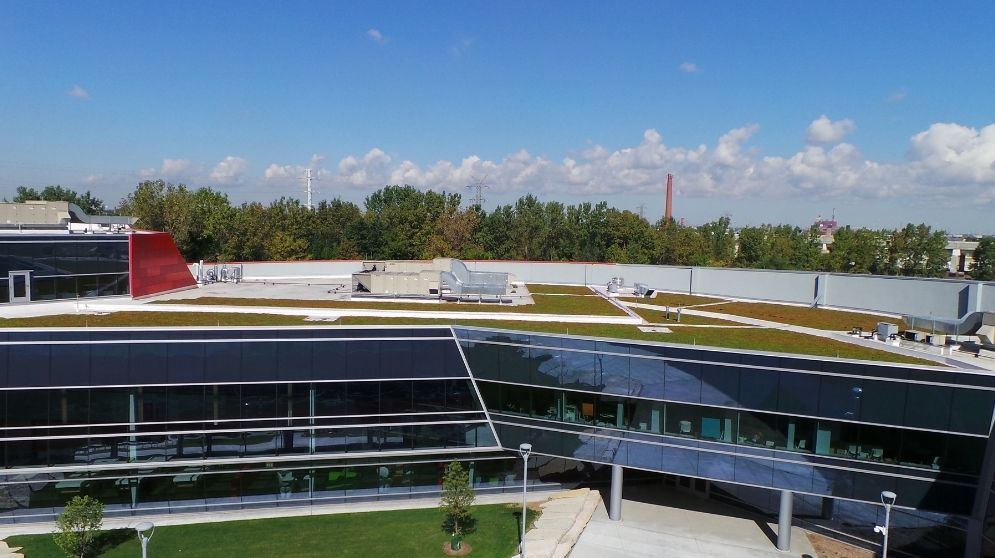Property owners and facility managers across the country continue on a quest to have their buildings become more energy efficient and sustainable. As a result, they’re creating a host of new challenges and opportunities for the roofing contractors and other construction professionals that they trust in order to help reach their goal.
As discussed previously in this blog series, the leading options for energy-efficient roofs systems are often selected based on the number of heating or cooling degree days likely to impact the building. Scientists determine the heating and cooling-day measurements on the assumption that an outdoor temperature of 65-degrees Fahrenheit does not require heating or cooling for the people inside a structure to feel comfortable. The roof can play a big part of that performance, and particularly for buildings in desired cooling day environments. There are three main options for contractors to consider for maximizing cooling days — reflectivity, insulation levels and vegetative surfaces.
Building owners in climates that present more cooling than heating days generally will prefer a surface that reflects heat rather than absorb and retain it. These are commonly referred to as cool roofs, which by definition meet or exceed the minimum solar reflectance and thermal emittance rating systems determined \ specifications, local, county, or state building codes, government energy laws, and/or Energy Star and Title 24. Cool roof systems are often listed by the Cool Roof Rating Council (CRRC) which is a voluntary program which regulates the test methods used to evaluate cool roofs.
Currently, products like Johns Manville TPO, JM PVC, and JM PVC SD Plus along with select SBS and BUR membranes are listed in the Cool Roofs Directory. https://coolroofs.org/directory
A full host of rated products and other valuable resources are available on the CRRC website. https://coolroofs.org/
Vegetative
Another option in these cases are vegetative roofs, which have water-absorbing capabilities and can help reduce a building’s energy output from the start. When installed and working properly, a vegetative roof helps protect a roof’s surface from harmful ultraviolet rays, which can help improve longevity. It can also help maintain and manage stormwater runoff, and in some cases eliminate it altogether. These elements also help offset any thermal heat gained from the sun’s rays and can lead to reduced urban heating issues by increasing the albedo — the fraction of solar energy reflected without absorption. https://rci-online.org/vegetative-roofs-problem-future/
Keep in mind that vegetative roofs can add additional weight to the roof, so it is important to verify the current structure can handle that weight before you consider vegetative options. Despite some initial hesitations over costs and maintenance requirements of vegetative roofs, much of the roofing industry has come to understand the benefits over the past decade.
“A vegetative roofs’ albedo and reflectivity performance are not negatively impacted by the factors affecting cool roofs, and what’s more, cool roofs offer no benefits relative to roof longevity or stormwater management,” wrote Jon Crumrine, vice president of business development for DiademUSA, in an article published on the RCI website. The demand appears to be growing as people learn more about the viability in various climates.
The Freedonia Group, a Cleveland-based industry research firm, forecasted the demand for complete green or vegetative roofing systems in the United States to grow by at least 11 percent annually through 2023, making a market potential of more than $278 million.
Insulation
As mentioned, insulation is becoming a more important part of the overall energy efficiency conversation, as are the coverboards and other products emerging to help protect it. Adding layers of insulation to a roofing system can help lower energy consumption, and thus costs, because less heat is able to move through the system. Properly installed insulation can also lessen or prevent energy transfer from buildings and the occupants that are inside.
The science is relatively simple: heat travels and always flows from warm to cold until the temperature difference disappears. The more insulation, the less ability for heat to escape during cold days, and less heat enters the structure on warmer interior cooling days. Both translate to direct energy savings and a reduced carbon footprint.
As always, roofing contractors should follow industry best practices, including the recommended R-value for their particular region in the International Energy Conservation Code (IECC). The IECC provides two ways to determine a commercial property’s insulation requirements: specific tables established within regional codes, or adherence to the American Society for Heating, Refrigerating and Air-Conditioning Engineers Inc. (ASHRAE) Standard 90.1.
The National Roofing Contractors Association (NRCA), in conjunction with the Roofing Alliance, developed the EnergyWise Roof Calculator Online, a free, web-based app based on the ASHRAE standard. Click here for more information. http://energywise.nrca.net/
In Conclusion
The first decision a building owner or facility manager may have to make when it comes to maximizing energy use could start at the very top. Whether clients choose a reflective or vegetative surface, or incorporate additional insulation with either type of roof system, the time is now for roofing contractors to seize the opportunity and capitalize on the increased interest in cool roof options by getting educated on the systems.

